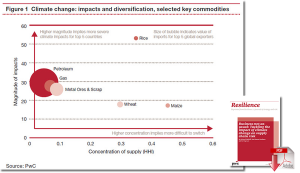- January 23, 2015
- 5:43 pm
- John Caltagirone
- no comments
Global Warming Disrupting Supply Chains
While 2014 in Chicago was considered the year of the polar vortex and Chiberia, on average, for the rest of the world, it was the hottest year on record since 1880. Average temperatures were up by 1.4°F or 0.8°C in 2014, setting heat waves throughout many parts of Europe, Northern Africa, and parts of South America.
Moreover global warming hasn’t been exactly a exponential curve since the beginning of time, in fact some years have been much cooler, but on a general average it has been warmer since the 20th century. Global warming has been on our radar for years now. Ice caps in Antarctica sinking and polar bears drowning have become old news. Increased deforestation and burning of fossil fuels continue to be the main causes of a deteriorating ozone layer.
Apart from environmental destruction, the magnitude of global warming and climate change extend into other sectors as well including supply chain. Supply chain are disrupted, both man-made and natural, as a result of extreme weather conditions brought on by climate changes. For example, in 2010, Russia was exposed to a heat wave that caused wildfires and drought leading to the destruction of crops and economic losses of $15billion USD. This was merely a catalyst to the existing export restrictions of wheat in Russia, causing the global prices of wheat to rise.
The risk caused by global warming for supply chains is not in the extreme weather conditions, but in the interdependency of these occurrences and existing risks such as the Russian example.
According to PWC’s 2013 report “Business-not-as usual: Tackling the impact of climate change on supply chain risk,” the three sectors most affected by climate change risks are agriculture, mining and energy. There are two specific risk exposures that greatly impact these sectors: 1) The magnitude of the impact of climate change on the commodity 2) The concentration of the suppliers.
In terms of the former, commodities are twofold. They depend on the effects of the temperature and precipitation, rise in sea levels, weather conditions, and secondly, the country’s ability to manage the commodity among issues including, but not limited to, the political stability of the country, governance, and even the socioeconomic development within the nation.
The second risk exposure is the concentration of the suppliers. If commodities are subjected to a small number of suppliers, when there is a disruption in the supply chain with one major supplier it can cause issues to the whole system. The image below displaces this disparity.
The above information assumes that in large part the risk also depends on the commodity type. The likelihood of petroleum or energy sectors being vastly impacted by climate change as they are to be later effected by its availability of suppliers. As for agricultural commodities like rice or maize are more highly dependent on weather conditions.
In order to diminish or at least lessen the impact of climate change risk, the PWC suggested that businesses and governments need to keep from viewing these risks in isolation, begin strategize risk management procedures, and begin to collaborating with international resources.
-Riti Patel, Assistant, Supply and Value Chain Center
Sources:
